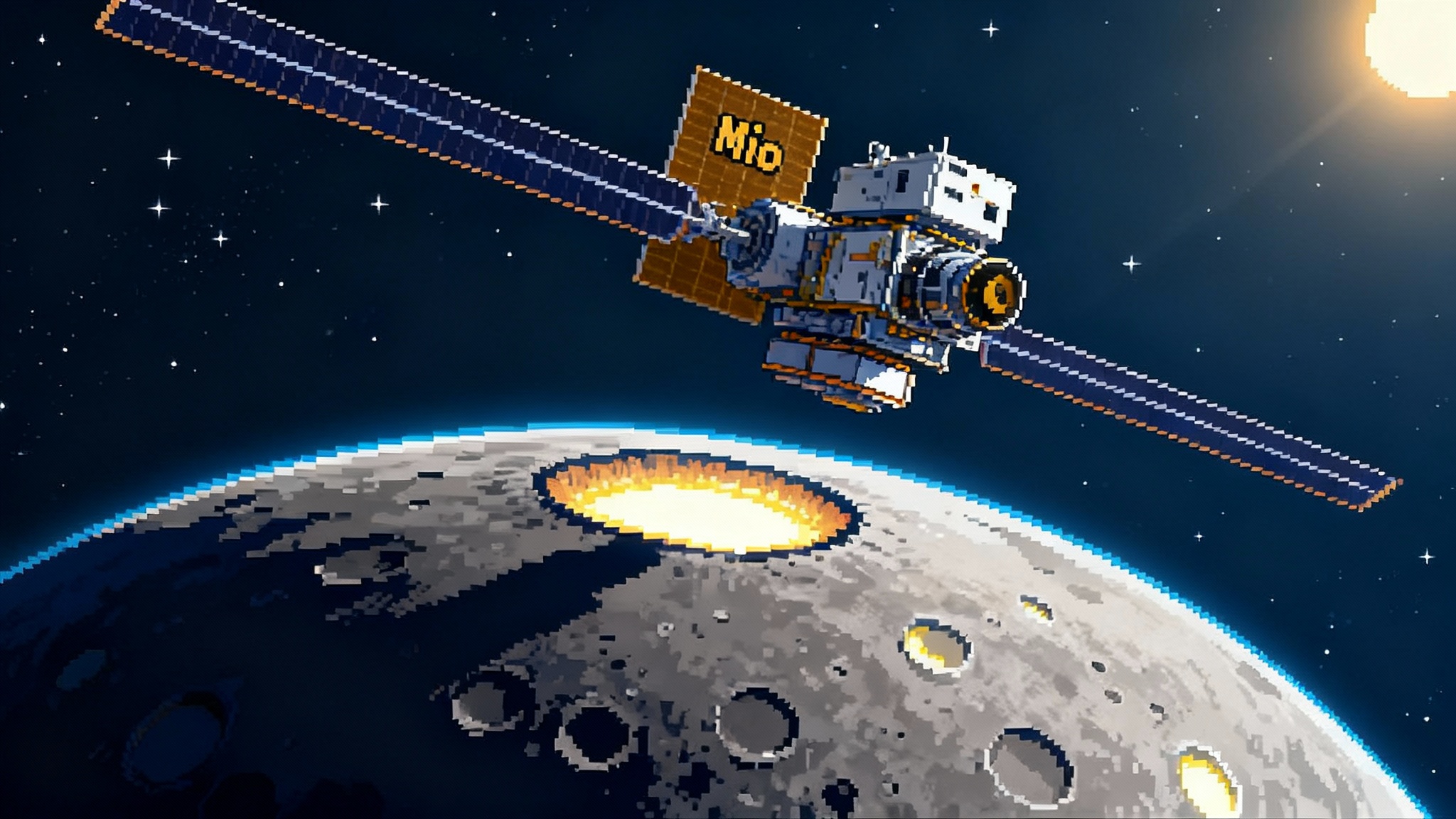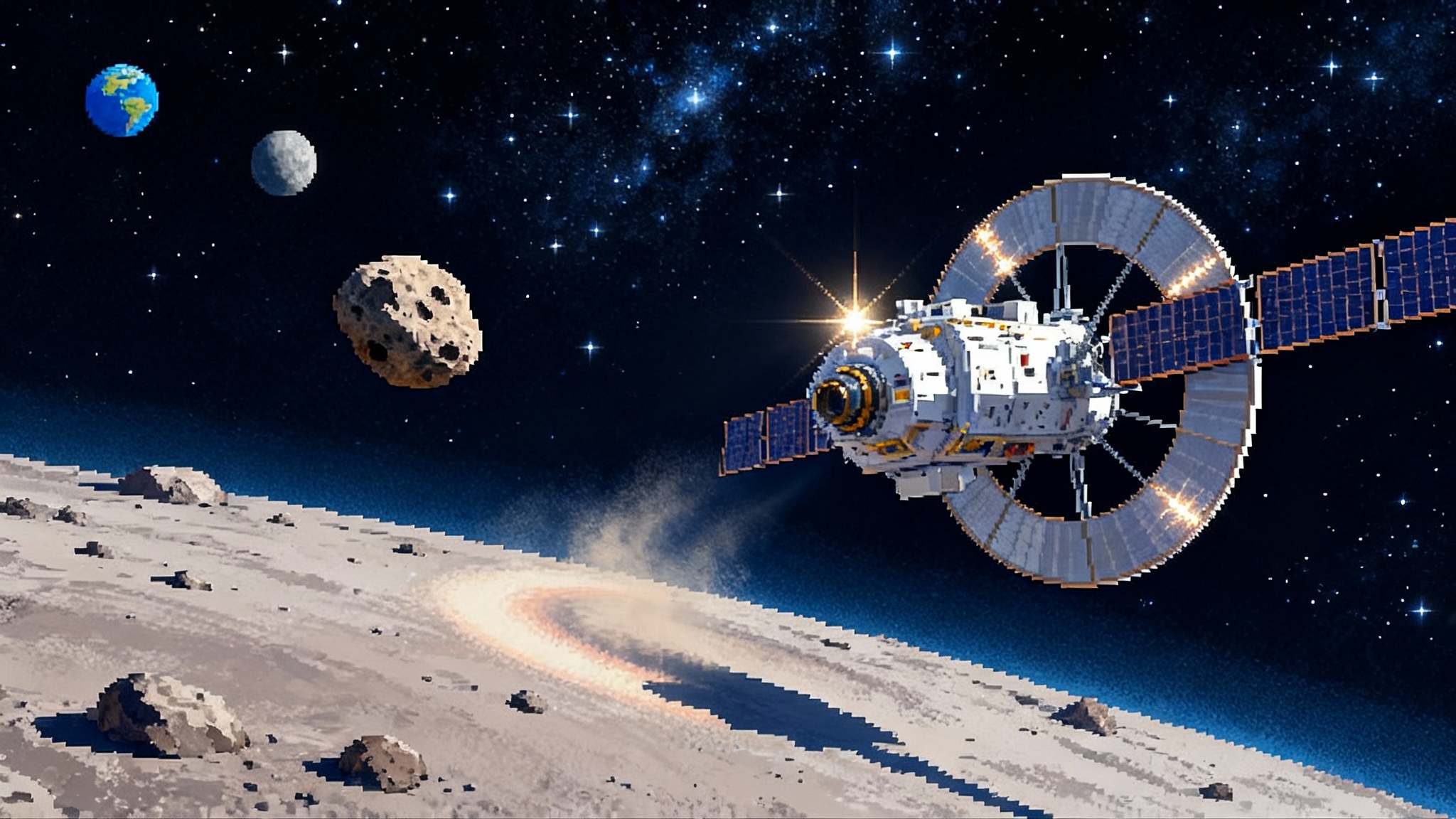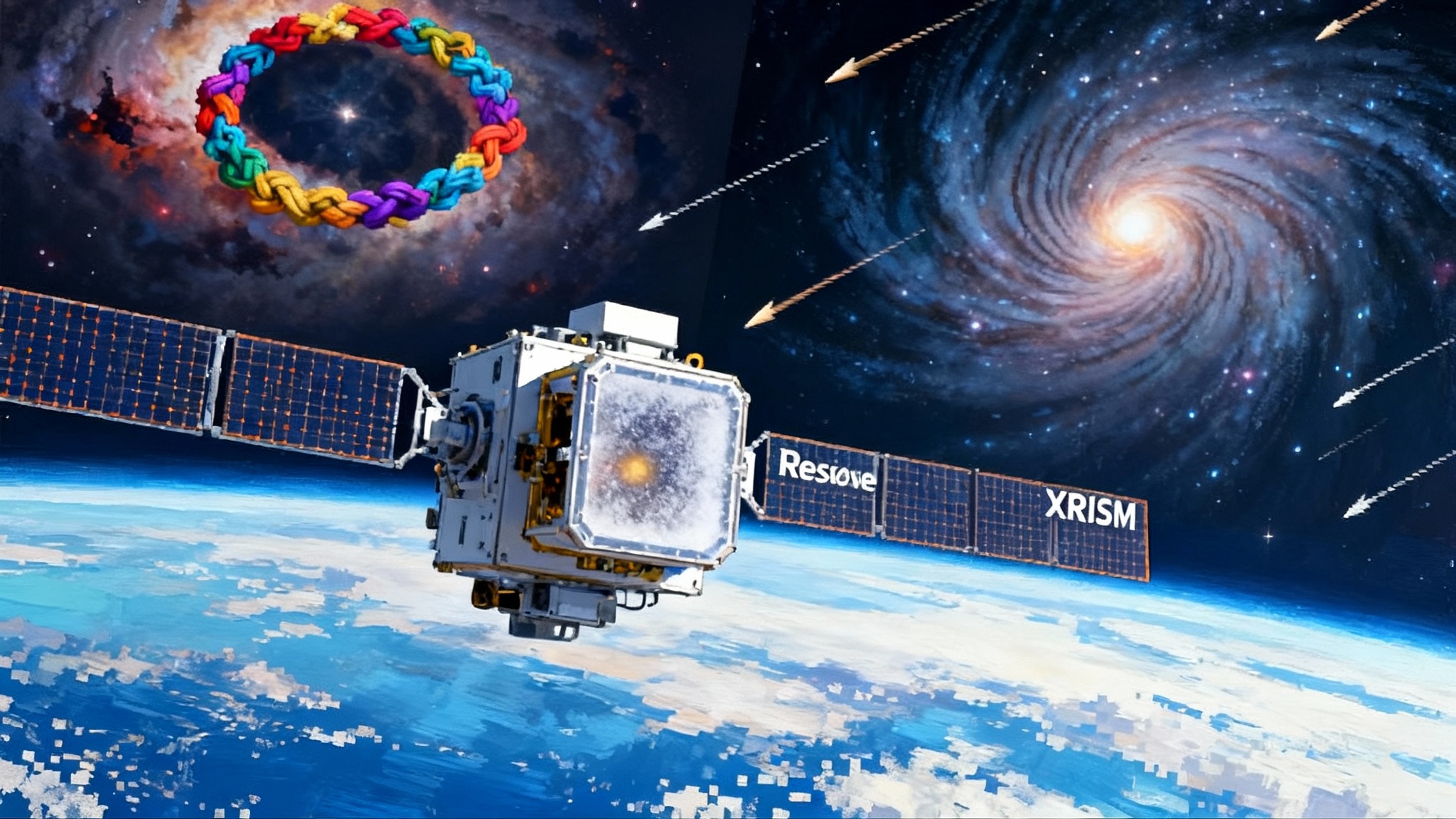BepiColombo’s pivot to Mercury after a thruster glitch
A power shortfall in BepiColombo’s transfer module forced ESA and JAXA to rewrite the cruise. Anchored to the January 8, 2025 flyby, here is how they preserved a late 2026 capture and which science turns on first.

The flyby that changed the plan
On January 8, 2025, BepiColombo skimmed just 295 kilometers above Mercury’s night side, crossed over the north pole, and vanished again into deep space. It was the sixth and final flyby before the spacecraft commits to the innermost planet. The pass was more than a postcard moment. It was the hinge that let mission teams pivot from a problem to a plan.
The problem surfaced in April 2024. The Mercury Transfer Module, the bus that hauls the science orbiters to their destination with ion propulsion, could not deliver full power to its thrusters. Engineers traced the culprit to unexpected electrical currents between the transfer module’s solar arrays and a power distribution unit. That meant less power to the ion engines and less thrust than the original capture plan required. Rather than accept defeat or wait for a miracle fix, the European Space Agency’s flight dynamics team and the Japan Aerospace Exploration Agency rewrote the cruise. They would squeeze more performance out of gravity, change the timing of thrust, and arrive almost a year later with the science intact. The agency detailed the diagnosis and the workaround in ESA’s new trajectory note.
If that sounds like software hotfix thinking applied to celestial mechanics, that is not far off. Where a developer might refactor code to route around a failing library, the team refactored an entire flight plan to route around a power bottleneck.
Trajectory hacking 101
Interplanetary navigation is rarely a straight line. The Sun’s gravity is a headwind on the inward journey, so missions brake against it using a mix of low thrust and gravity assists. BepiColombo’s original recipe was nine flybys in total and many months of ion thrust. With the power shortfall, the team leaned harder on the geometry of the last three Mercury flybys. They dipped a little lower on one flyby to harvest extra braking from Mercury’s gravity, then used the January 2025 pass to branch onto a new path that required less thrust overall. The price was time. Arrival slipped from late 2025 to late 2026. The payoff was mission resilience without adding propellant or risking new failure modes. Lessons from ESA’s careful gravity choreography echo the mindset in Hera’s Mars flyby setup.
That final flyby over the north pole also doubled as a rehearsal. The spacecraft endured a long eclipse on approach, running only on batteries while ice-cold darkness crept over its radiators. Mission control preheated subsystems ahead of time, charged batteries to the brim, and watched temperatures and voltages like a cardiac team through an angioplasty. This is what modern deep-space work looks like: test as you fly, fly as you test, and bake flexibility into the plan.
What happens first in late 2026
BepiColombo is a stack of three major pieces that will soon go their separate ways.
- Mercury Transfer Module. Its job ends just before capture. The module separates, taking its ailing power system and selfie cameras with it.
- Mercury Magnetospheric Orbiter (Mio), led by JAXA. A spinner built to taste electric fields, plasma, magnetic fields, sodium glow, and dust in Mercury’s space environment.
- Mercury Planetary Orbiter, led by ESA. A three-axis stabilized mapper packed with cameras and spectrometers for the surface, interior, and exosphere.
The choreography goes like this. First, the stack uses a technique called weak stability boundary capture. Instead of one giant burn, the spacecraft arrives nearly coasting alongside Mercury so the planet can “grab” it into a very elongated orbit. The transfer module is already gone by then. Next comes separation. Mio is released first into a big elliptical polar orbit and spins for stability. The protective sunshield that kept Mio cool during the years-long cruise is then jettisoned. The planetary orbiter remains and uses chemical thrusters to step down into a much lower polar orbit suited for mapping. JAXA’s Mio page summarizes the two-orbit dance clearly in placing the two satellites into different orbits.
Within days of separation, the first instruments to power on are the ones that do not demand exquisite pointing or tight thermal stability. Expect health checks, then the field and particle instruments to begin streaming data from Mio’s magnetosphere orbit. Magnetic field sensors and plasma detectors are bread-and-butter tools for a spinning spacecraft. They can produce useful science during commissioning while the team tunes the spin rate and communication cadence.
On the ESA orbiter, early commissioning will focus on power, thermal control, and attitude performance. The magnetometer and the Italian Spring Accelerometer, which help characterize forces and fields, are also likely early risers because they support navigation and science. The high-resolution surface instruments will follow as soon as the spacecraft is thermally stable in its mapping altitude and pointing is rock solid. Cameras and spectrometers want predictable Sun angles and repeatable ground tracks.
The first hits to watch
Three science themes will dominate the early months. Each has a clear set of instruments and a clear reason to go early.
- Mercury’s crust chemistry
- What it answers. Mercury is unusual. It has an oversized iron core, a crust rich in volatiles by some measures, and a surface that looks simple from a distance but shows complex geologic patches up close. The big questions are elemental: how much sodium, magnesium, aluminum, and sulfur are in the crust, how they vary with geology, and what that says about how Mercury formed.
- Why it can start early. Sunlit mapping can begin as soon as the planetary orbiter is stable. Two instruments drive the early returns. The Mercury Imaging X-ray Spectrometer will use the Sun’s X-rays in a trick called X-ray fluorescence. Sunlight knocks inner electrons out of surface atoms; when the atoms relax, they emit X-rays with fingerprints of specific elements. Solar flares act like flashbulbs that brighten the whole scene, so the best data sometimes arrive in bursts. The Mercury Gamma-Ray and Neutron Spectrometer listens for gammas and neutrons born from cosmic ray interactions in the upper few centimeters of the regolith. Neutrons point to hydrogen; gamma rays trace major elements.
- What to look for first. Expect maps that show element ratios across volcanic plains and impact basins. If the mission catches a solar flare soon after commissioning, the team may publish fast X-ray snapshots of elemental contrasts around the giant Caloris impact basin. Those early maps will test competing models for Mercury’s mantle and the story of how it lost or kept volatiles.
- Exosphere dynamics
- What it answers. Mercury does not have a thick atmosphere. It has an exosphere, a thin veil of atoms and molecules constantly being sputtered off the surface by micrometeoroids and the solar wind, then lost to space or falling back. The pattern changes by local time, by magnetic field configuration, and by solar activity. Understanding that pattern is key to understanding how a small, hot planet interacts with the Sun.
- Why it can start early. Mio is built for this. Its magnetometer, plasma wave sensors, particle detectors, and the Mercury Sodium Atmospheric Spectral Imager will measure the environment above the poles and flanks where the solar wind connects directly to the planet. On the planetary orbiter, the SERENA package and the ultraviolet spectrometer PHEBUS will taste neutral and ionized particles from lower altitudes. Because these instruments do not need postcard-perfect pointing, commissioning blends quickly into science.
- What to look for first. Two-point measurements. With one orbiter low and the other high, the team can watch disturbances blast through the system, timing the response like a cardiologist timing a heartbeat. Watch for early plots that show how sodium and other species vary as magnetic field lines open and close at the polar cusp. Rapid changes here validate models of space weather at Mercury and also help engineers design better spacecraft shielding for heat and radiation.
- Polar ice in the shadows
- What it answers. Mercury’s poles host craters whose floors never see the Sun. Radar has long hinted that these cold traps hold water ice mixed with darker organics. That is unexpected for a planet that bakes near the Sun.
- Why it can start early. Three tools converge. The BepiColombo Laser Altimeter maps slopes and depths so we know exactly where the cold traps are and how sunlight grazes their rims. The gamma and neutron spectrometer can sense hydrogen enrichments that point to buried ice. Thermal measurements from the Mercury Radiometer and Thermal Imaging Spectrometer outline the boundaries where temperatures stay low enough for ice to persist. None of these demand early postcard imaging. They demand patience and repeated passes, which begin as soon as the mapping orbit is stable.
- What to look for first. Expect elevation profiles through named polar craters and the first temperature mosaics that show which patches are cold enough to trap volatiles. If hydrogen enhancements correlate with those patches, the team will have a strong early case for where the purest ice sits and where it mixes with dust.
What a delay buys you
A one-year delay sounds painful. Here is what it actually bought.
- Safety margin. The alternative was to push low-power thrusters beyond their tested envelope. By changing the geometry instead, the team kept forces and temperatures inside known limits.
- Science intact. The two-orbiter design was built to deliver surface and environment science in parallel. The new cruise preserves that duality. Arrival is later, but the science menu is unchanged.
- Better rehearsal. Each flyby now has elevated value. Flybys let instruments taste regions that may be hard to sample again in orbit, such as the precise path through the northern cusp on the January 2025 pass. Those measurements feed into calibration files and observation plans so the team spends less time tuning in 2027.
Think of it like a long mountain approach. If your main trail is blocked, the smart move is not to sprint up a scree slope. It is to contour across the ridge, hit a shoulder at the right angle, and summit with steady lungs. The summit is still the summit.
Inside the control rooms
Two operations cultures meet in this mission. ESA’s European Space Operations Centre in Darmstadt runs the cruise, the separations, and the planetary orbiter. JAXA’s Sagamihara Space Operations Center runs Mio once it is free and clear. That split is not a complication. It is the feature that makes two-point science possible. The same is true on the ground segment. ESA’s 35-meter deep space stations and JAXA’s 64-meter Usuda antenna build a round-the-clock link that can catch brief downlink windows at Mercury’s distance while the spacecraft battles the Sun’s glare and heat.
The teams also built failure tolerance into the hardware stack. Mio spins for stability and rides behind a sunshield during cruise. The planetary orbiter carries its own chemical propulsion for the job of lowering into a tight mapping orbit. If one element goes quiet, the other can still do real science. That redundancy is the quiet story behind the pivot.
A watcher’s guide to late 2026 and early 2027
Here is how the first months are likely to unfold once capture starts.
- Capture and separation. Expect a public callout when weak capture is confirmed. The transfer module will already be gone. Mio separates and spins. The sunshield comes off. The planetary orbiter begins orbit-lowering burns.
- Early data. Mio’s field and particle plots will be first across social feeds. Look for time-correlated traces of electric fields, radio waves, and magnetic field components. Those are commissioning gold because they also validate the orbit geometry.
- First maps. Within weeks of a stable mapping altitude, the planetary orbiter can begin laser profiles and thermal stripes at high latitudes. Elemental X-ray maps may follow quickly if the Sun cooperates with a small flare.
- First pictures. The main camera suite and imaging spectrometers, which were shadowed by the transfer module during cruise, will take their first targeted images. Expect high-resolution views of the northern plains and edges of Caloris with lighting carefully chosen for shadows and texture.
Why this matters beyond Mercury
The industry has been shifting toward agile, failure-tolerant operations for a decade, but the shift usually shows up in software or in computing on the spacecraft. BepiColombo shows what happens when you apply those ideas to navigation and mission design.
- Find the off ramps early. Weak stability capture is an off ramp baked into the plan. It avoids the single big burn that would have left no room for error if the thrusters underperformed. Similar thinking shows up in tightly constrained opportunities like Europa Clipper’s narrow window.
- Treat gravity as a tool, not a constraint. When hardware faltered, the team did not reach for more hardware. They reached for geometry. That mindset is transferable to small companies building resource-limited deep-space probes.
- Design for two-point science. The twin-orbiter architecture is harder and heavier on Earth, but it pays off for dynamics and timing once you arrive. If budgets allow, it is the fast lane to understanding how a system breathes and changes in time. The same design courage underpins operational redesigns like HTV-X1 rewired space cargo.
The practical takeaway for mission designers is simple. Build slack into the plan where physics, not money, carries the load. Put complementary sensors on platforms that can observe the same phenomenon from two vantage points. Make the first few months in orbit a science phase, not a passive checkout. That is how you get early wins even if the cruise throws a curveball.
The bottom line
BepiColombo will not reach orbit until late 2026, nearly a year after its original date, because an electrical quirk cut the legs out from under its ion engines. The response was not a lament. It was a redesign in flight. The final flyby in January 2025 was the keystone of that pivot, after which the mission set up for a gentle capture and a two-orbiter ballet around the smallest planet.
When the two spacecraft separate, the first lights will be fields, particles, and laser pulses. The early headlines will be maps of elemental chemistry, fast-changing exosphere plots, and the first thermal and height profiles that outline where polar ice can hide in the dark. The deeper headline is this: agile, failure-tolerant operations are not just slogans from software. They are how deep-space exploration is accelerating even as missions grow more ambitious. BepiColombo’s pivot shows that if you design your mission like a system that can learn, you can still meet your science on time even when your hardware blinks.








